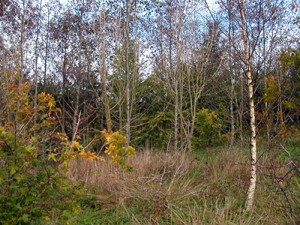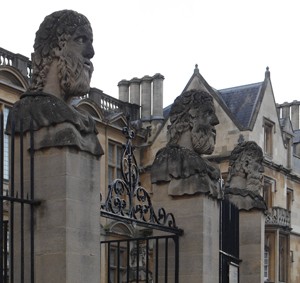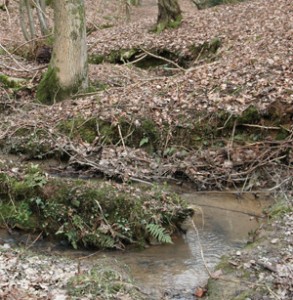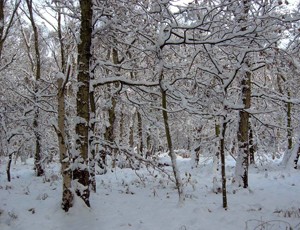“Connected woodlands”

In the early 1970’s, Professor Barry Commoner (Washington University) said that ‘the first law of ecology’ could be stated as “Everything is connected to everything else”. That is, there is one ecosystem for all living organisms and what affects one – affects all.
He was much concerned with the interactions of organisms, and the concept of sustainability. Traditionally, connectedness in ecology is concerned with how one organism affects another, or how an organism affects the environment or how a change in an environmental factor affects the organisms in the ecosystem. For example, earthworms drag dead and decaying leaves into the soil thereby enriching its nutrient studies, improving its drainage, aeration etc. Changes in carbon dioxide level will affect the photosynthetic activity of many plants.
 Ecology is concerned with understanding this connectedness, and ecological studies often focus on particular organisms (autecology) or specific areas. One such area is Wytham Wood, which is said to be the most intensely studied woodland in the world. The area includes ancient semi-natural woodland, secondary woodland, grassland and ponds. It is a designated SSSI, where some 500+ plant species and 800+ lepidopteran (butterfly and moth) species have been recorded. Records of bird populations go back some sixty or more years (starting with the work of David Lack); other ecological studies with long-term data include those on badgers, and work on climate change. Wytham Wood belongs to Oxford University. Harvard University also has its own woodlands at Petersham (in Central Massachusetts) – and these too have been been subject to intensive study.
Ecology is concerned with understanding this connectedness, and ecological studies often focus on particular organisms (autecology) or specific areas. One such area is Wytham Wood, which is said to be the most intensely studied woodland in the world. The area includes ancient semi-natural woodland, secondary woodland, grassland and ponds. It is a designated SSSI, where some 500+ plant species and 800+ lepidopteran (butterfly and moth) species have been recorded. Records of bird populations go back some sixty or more years (starting with the work of David Lack); other ecological studies with long-term data include those on badgers, and work on climate change. Wytham Wood belongs to Oxford University. Harvard University also has its own woodlands at Petersham (in Central Massachusetts) – and these too have been been subject to intensive study.
However, connectedness has another meaning when applied to the woodland at Petersham. Now, the woodland is connected to a vast array of sensors, data-loggers, and computers. The sensors / monitoring devices record information about trees, leaf cover, the vocalization of birds, insects and other animals, the flow rate of streams, the pH of the water, air speed (the wind), humidity.  What began (decades ago) as a project to monitor the health of trees and vegetation has evolved into a high tech project that monitors nearly every aspect of woodland dynamics, including the rivers and streams and the air currents that pass through the trees. Within the woodland, a wireless network is formed from five towers (that emerge above the tree tops) – which can transmit data via radio links at high rates); these connect with a dozen 900 MHz radios that can send their information through wood and leaves (high frequency signals become attenuated by vegetation) and at ground level there are WiFi access points, which provide internet access for laptops and smartphones. Each site in the woodland has various devices and sensors associated with it. Some (essentially electronic weather stations) are gathering meteorological data (every second!) – air and soil temperature, precipitation / rainfall, solar radiation (light intensity etc.), humidity. Some (acoustic sensors powered by raspberry-pi) are ‘secreted’ in the undergrowth listening – these record sounds within a 10 metre radius. These are compressed and transmitted to Boston. The aim is to develop algorithms which will identify different forest species – thus, the sensors will supply data that will enable researchers to determine (remotely) when the first cricket chirps, when migratory birds arrive, and correlate these observations with various environmental variables like temperature.
What began (decades ago) as a project to monitor the health of trees and vegetation has evolved into a high tech project that monitors nearly every aspect of woodland dynamics, including the rivers and streams and the air currents that pass through the trees. Within the woodland, a wireless network is formed from five towers (that emerge above the tree tops) – which can transmit data via radio links at high rates); these connect with a dozen 900 MHz radios that can send their information through wood and leaves (high frequency signals become attenuated by vegetation) and at ground level there are WiFi access points, which provide internet access for laptops and smartphones. Each site in the woodland has various devices and sensors associated with it. Some (essentially electronic weather stations) are gathering meteorological data (every second!) – air and soil temperature, precipitation / rainfall, solar radiation (light intensity etc.), humidity. Some (acoustic sensors powered by raspberry-pi) are ‘secreted’ in the undergrowth listening – these record sounds within a 10 metre radius. These are compressed and transmitted to Boston. The aim is to develop algorithms which will identify different forest species – thus, the sensors will supply data that will enable researchers to determine (remotely) when the first cricket chirps, when migratory birds arrive, and correlate these observations with various environmental variables like temperature.
 Digital cameras mounted on the towers can monitor the changing colour of leaves in the Spring and the Fall (Autumn). Phenology, is the study of specific events in plant and animal life-cycles; and how these events are influenced by seasonal and annual variations in climate – it has been at the centre of the Harvard project since its inception. Thermal cameras (that move on wires above the canopy) provide information about how the leaves respond to heat stress, whilst other sensors record canopy height, light (wavelength) absorbance etc. Sensors on the towers measure the air composition at different heights, thereby measuring the utilization of carbon dioxide, the release of water vapour from stomata / transpiration, as well as recording levels of pollutants such as nitrogen oxides and ozone.
Digital cameras mounted on the towers can monitor the changing colour of leaves in the Spring and the Fall (Autumn). Phenology, is the study of specific events in plant and animal life-cycles; and how these events are influenced by seasonal and annual variations in climate – it has been at the centre of the Harvard project since its inception. Thermal cameras (that move on wires above the canopy) provide information about how the leaves respond to heat stress, whilst other sensors record canopy height, light (wavelength) absorbance etc. Sensors on the towers measure the air composition at different heights, thereby measuring the utilization of carbon dioxide, the release of water vapour from stomata / transpiration, as well as recording levels of pollutants such as nitrogen oxides and ozone.
As the data accumulates over the years / decades, it should provide valuable information about how woodland organisms of all types respond to climate change and perhaps provides some answers about how to mitigate the effects of increasing carbon dioxide levels and global warming.
Comments are closed for this post.

[…] http://www.woodlands.co.uk/blog/flora-and-fauna/connected-woodlands/ […]
How to tech up a wood | theliminalwood
30 March, 2015